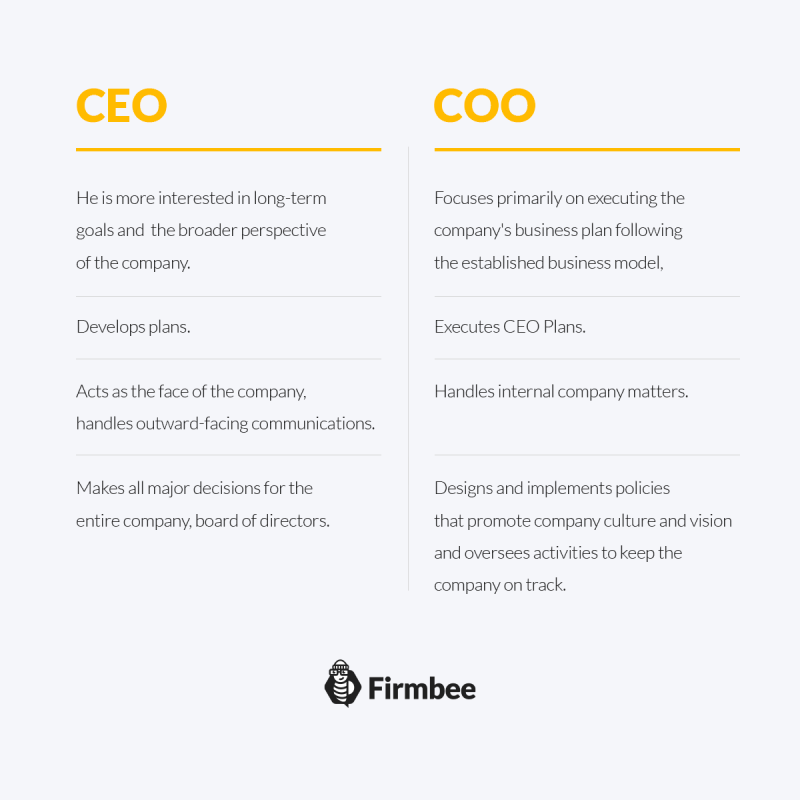Are you wondering who is the COO? In many companies, especially large ones, you need a person who oversees all the processes that take place in the organization. In most companies, this is the chief operating officer, the second person in the company after the CEO. He or she knows what everyone is currently doing in the various departments as well as what problems the company and its employees are struggling with. So today let’s take a look at who the COO is and what his role in the organization is.
What is the COO and what are their responsibilities? – table of contents:
- What is the COO?
- The role of the COO
- Responsibilities of the Chief Operating Officer
- Types of COOs
- COO vs CEO
What is the COO?
The COO, or chief operating officer, is responsible for the day-to-day business operations of a company. This is the person who directly reports to the president (CEO) and plays an integral role in leading the organization. The relationship between these two individuals in a company is apparent. The CEO is the visionary, so to speak, while the COO has an executive function. The COO develops strategies and sets goals for the organization as well as oversees the daily administrative and operational functions of the company.
The role of the COO
The role of the COOs is vital to the organization because they run the day-to-day business operations of the company, working closely with department managers and supervisors to support the day-to-day activities of employees. While the CEO is more concerned with holistic elements, such as the company’s overarching goals and strategy, the COOs typically oversee internal, day-to-day operations. In doing so, they support the CEO’s vision and strategy.
COO roles and responsibilities
The COO creates the strategic vision and management of the organization and oversees the management, operational and administrative processes within the company. It is important that he/she communicates with other teams and ensures cross-collaboration to improve performance.
Key COO Responsibilities:
- Builds and creates a team of top professionals
- Will align the company’s financial and operational outlook with other key members.
- Sets goals for individual and team development within the organization.
- Drives strategy to achieve favorable results financially.
- Creates communication processes and implements effective development strategies.
- Works with teams to process internal ideas, infrastructure and programs.
- Provides reports on the company’s investigations.
- Motivates and encourages the implementation, and allocation of resources and processes within the company.
- Works with investors, suppliers, banks, customers or other professionals.
- Represents the company at various forums, events, meetings and trips.
- Analyzes and monitor which departments can be improved and strengthened.
- Participates in keeping employees engaged and invested in processes and resources.

Types of COOs
There are seven primary reasons why companies choose to hire a COO this establishing seven roles that COOs can play in an organization. These roles are:
- Contractor. The role of the COO is to lead the execution of strategies developed by the top management team. It assumes subordination to the CEO. Managing large, often global companies sometimes requires two pairs of hands; in such cases, the COO typically takes responsibility for delivering day-to-day, quarter-to-quarter results.
- The other half. A company can get a COO not as a mentor, but as someone who complements the CEO’s experience, style, knowledge base or tastes.
- Mentor. Some companies hire a chief operating officer to mentor a young or inexperienced CEO (often the founder). A fast-growing entrepreneurial venture may seek out an industry veteran with experience, wisdom and a rich network who can develop both the CEO and the growing company.
- Change Agent. Hired or promoted internally when a company seeks changes of procedures or structures to improve the company.
- Partner. When the CEO is equally involved with the COO in running the company together.
- Heir. In many cases, the primary reason for becoming a chief operating officer is to prepare or test the company’s president-elect. The broad scope of the job allows the heir to get to know the entire company: its business, environment and people.
- MVP. Finally, some companies offer the COO position as a promotion for a director who is deemed too valuable to lose.
COO vs CEO
Let’s go over the differences that exist between the positions: of CEO and COO. They are presented in the table below.

Who is the COO? In this article, we got an answer to this question. The Chief Operating Officer (COO) is a role that combines the functions of a chief executive officer and a manager. It is a role that is crucial for the company to achieve its goals, especially when the company structure is extensive. The binder in the form of the COO then proves as a key figure important for the company’s employees. It’s the one who can consult with the company’s management board on the direction of workers’ actions. The CEO treats the COO as chief deputy while the entire business can count on sustainable development thanks to the COO’s actions.
Read also: What is a CEO?
If you like our content, join our busy bees community on Facebook, Twitter, LinkedIn, Instagram, YouTube, Pinterest.
Author: Agnieszka Markowska-Szmaj


















